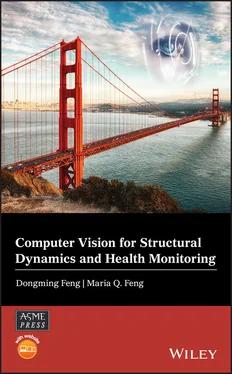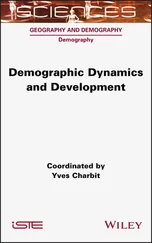1 In contrast to a contact‐type sensor (such as an LVDT or a string potentiometer), which requires time‐consuming, costly installation on the structure and physical connections to a stationary reference point, a computer vision sensor requires no physical access to the structure, and the camera can be set up at a convenient remote location. This represents significant savings of both time and cost. For monitoring bridges, for example, no traffic control is required. In addition, each contact‐type sensor measures one‐dimensional (1D) displacement, but a single computer vision camera can measure two‐dimensional (2D) displacements simultaneously. Figure 1.2 Vision‐based remote displacement sensor.
2 Compared with a noncontact GPS, which requires installation on the structure (but not a stationary reference point), a vision‐based sensor is far more accurate and less expensive. Depending on the cost, the GPS measurement error is typically in the range of 5–10 mm: more than an order of magnitude larger than that of a vision sensor.
3 Unlike a noncontact laser vibrometer, which must be placed very close to the measurement target due to the limited allowable laser power, a vision sensor can be placed hundreds of meters away (with the help of an appropriate zoom lens) and still achieve satisfactory measurement accuracy.
4 In contrast to conventional displacement sensors, almost all of which are point‐wise sensors, a single vision sensor can simultaneously track structural displacements at multiple points. More importantly, one can easily alter the measurement points after video images are taken, offering unique flexibility for achieving better SHM results.A comparison between commonly used vibration sensors and vision‐based displacement sensors is summarized in Table 1.1.
Table 1.1 Comparison of sensors for measuring structural vibrations.
| Sensors |
Measure |
Pros |
Cons |
| Wired or wireless accelerometer |
Acceleration |
Suitable for continuous monitoringHardware easily availableSensitive to high‐frequency vibrations |
High cost of sensor systemHigh cost of installation and maintenanceContact sensorSingle‐point measurementAdditional mass on the structure may affect output |
| LVDT |
Displacement |
Hardware easily available |
Difficult and costly to installContact sensorOne‐dimensional measurementSingle‐point measurement |
| Laser vibrometer |
Velocity or displacement |
NoncontactAccurate |
High cost of sensor systemNot suitable for continuous monitoringLimited measurement distance |
| Computer vision sensor |
Displacement |
Noncontact, continuous monitoringLow‐cost industrial or consumer‐grade video camerasTwo‐ or three‐dimensional measurementMultiple flexible measurement points on the visible object surface |
Accuracy affected by weather, light, and camera motion |
About 10 years ago, the research community started to develop computer vision–based sensor technology for displacement measurement of large‐size structures in controlled laboratory and challenging field environments. Modal analysis can be performed on the displacement data to extract natural frequencies and the mode shapes of a structure. Moreover, by analyzing the measured displacement time histories and modal analysis results, analytical models and parameters of the structure can be updated, damage detected, and structural integrity assessed. The adoption of vision sensors can significantly reduce the testing cost and time associated with conventional instrumentations. For example, Poozesh et al. [17] pointed out that testing a typical 50 m utility‐scale wind turbine blade requires approximately 200 gages (costing $35 000–$50 000) and about three weeks to set up a conventional strain gauge system, while by contrast, a multicamera system could streamline the blade‐testing process by eliminating the sensor instrumentation and reducing the setup time to two days.
It should be noted that computer vision sensing has been attracting attention and gaining popularity in two major areas of structural engineering: (i) vision‐based sensors for displacement measurement and their SHM applications for modal/parameter identification, damage detection, force estimation, and model validation and updating; and (ii) visual monitoring of structural surface for defect detection and condition assessment, including the use of unmanned aerial vehicles (UAVs) and machine learning techniques. The emphasis of this book is on the former application.
1.3 Organization of the Book
The goal of this book is to encourage the application of the emerging computer vision–based sensing technology not only in scientific research but also in engineering practice such as field condition assessment of civil engineering structures and infrastructure systems. This book may serve as a textbook for graduate students, researchers, and practicing engineers. Thus much emphasis has been placed on making computer vision algorithms and their applications in structural dynamics and SHM easily accessible and understandable. To achieve this goal, throughout the book, MATLAB computer code is provided for most of the problems that are discussed. Even though the book is conceived as an entity, its chapters are mostly self‐contained and can serve as tutorials and reference works on their respective topics.
Chapter 2 introduces fundamental facts about computer vision sensor systems and algorithms and software for measuring displacement time histories from video images. General principles are presented, including various template‐matching techniques for tracking targets and coordinate‐conversion methods for converting image pixel displacements to physical displacements. Vision sensor software packages are developed for real‐time multipoint displacement measurement based on two representative template‐matching techniques: upsampled cross‐correlation (UCC) and orientation code matching (OCM).
Chapter 3 presents a wide range of tests conducted in both laboratory and field environments to evaluate the performance of the vision‐based sensor system for dynamic displacement measurement. The accuracy of the measured displacement time histories is evaluated by comparing vision sensor results from tracking high‐contrast artificial targets or low‐contrast natural targets on the structural surface with those obtained with conventional reference sensors. The robustness of the vision sensor is examined against adverse environmental conditions such as dim light, background image disturbance, and partial template occlusion. The vision sensor system is also tested on outdoor in situ structures, including a pedestrian bridge, a highway bridge, two railway bridges, and two long‐span suspension bridges. Dynamic displacements induced by various excitations are measured during the daytime and at night from different distances with and without artificial targets installed. These tests confirm the efficacy of the computer vision sensor system for measuring structural dynamic responses in outdoor environments.
Chapters 4 – 7 demonstrate the use of measured displacement data for SHM. Chapter4compares modal analysis results based on displacement response data with those from conventional acceleration data. Furthermore, the identified modal parameters are used to update structural parameters such as the stiffness of a three‐story frame structure and to detect damage in a beam structure.
Chapter 5 describes a model‐updating approach for railway bridges, which is based on time‐domain optimization of analytical models using in situ measurement of the bridge displacement time histories under trainloads. A finite element model of the bridge is developed, considering the train‐track‐bridge dynamic interaction. A sensitivity analysis investigates the intrinsic effects of parameters of the train, track, and bridge subsystems on the dynamic response of the bridge. The model‐updating approach is applied to a short‐span bridge to identify train parameters such as speed as well as bridge structural parameters such as stiffness. The computer vision–based model updating approach can be developed into an effective tool for long‐term SHM of short‐span railway bridges.
Читать дальше












